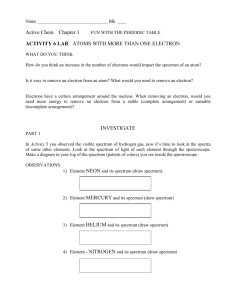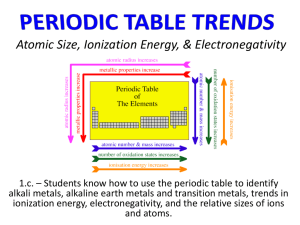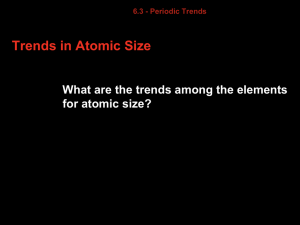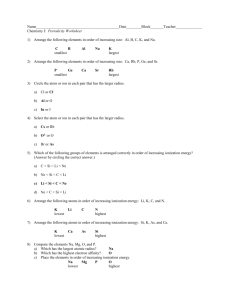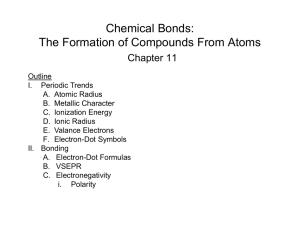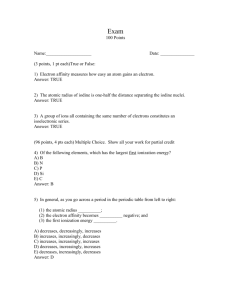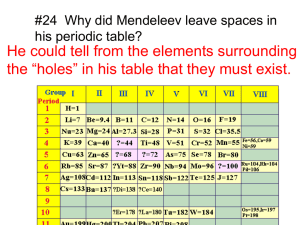Practice Test: Chapter 7 Periodicity QUESTION 1. Which of the
advertisement
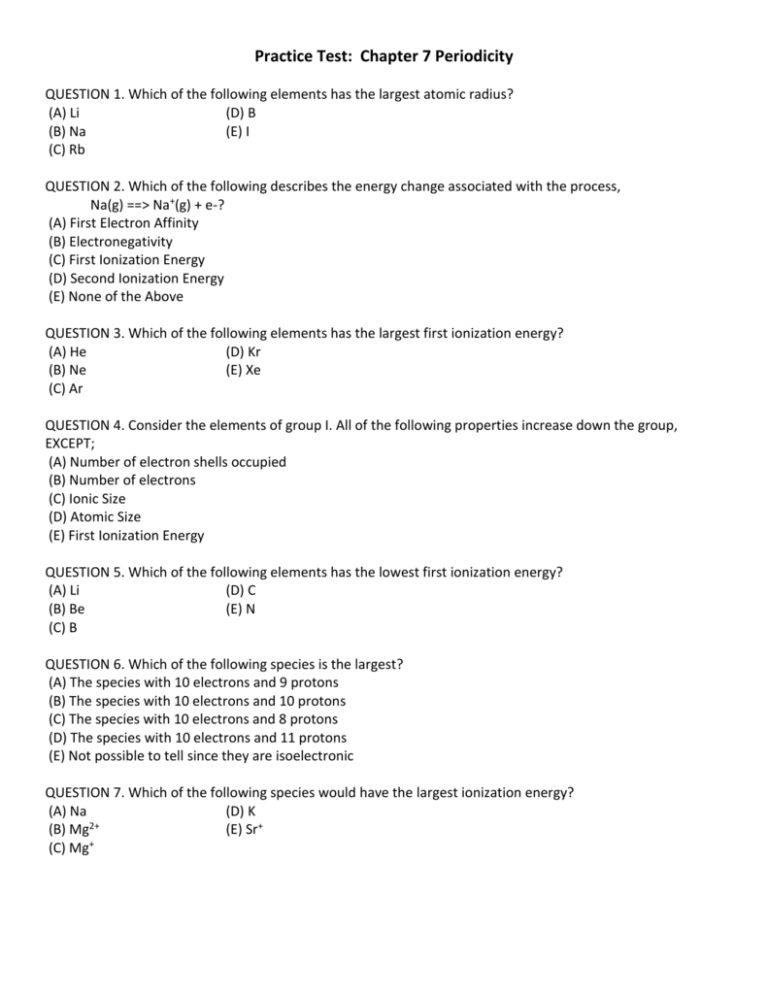
Practice Test: Chapter 7 Periodicity QUESTION 1. Which of the following elements has the largest atomic radius? (A) Li (D) B (B) Na (E) I (C) Rb QUESTION 2. Which of the following describes the energy change associated with the process, Na(g) ==> Na+(g) + e-? (A) First Electron Affinity (B) Electronegativity (C) First Ionization Energy (D) Second Ionization Energy (E) None of the Above QUESTION 3. Which of the following elements has the largest first ionization energy? (A) He (D) Kr (B) Ne (E) Xe (C) Ar QUESTION 4. Consider the elements of group I. All of the following properties increase down the group, EXCEPT; (A) Number of electron shells occupied (B) Number of electrons (C) Ionic Size (D) Atomic Size (E) First Ionization Energy QUESTION 5. Which of the following elements has the lowest first ionization energy? (A) Li (D) C (B) Be (E) N (C) B QUESTION 6. Which of the following species is the largest? (A) The species with 10 electrons and 9 protons (B) The species with 10 electrons and 10 protons (C) The species with 10 electrons and 8 protons (D) The species with 10 electrons and 11 protons (E) Not possible to tell since they are isoelectronic QUESTION 7. Which of the following species would have the largest ionization energy? (A) Na (D) K 2+ (B) Mg (E) Sr+ + (C) Mg QUESTION 8. Which of the following elements is likely to be the best oxidizing agent? (A) Sodium (B) Chlorine (C) Bromine (D) Iodine (E) Astatine QUESTION 9. Which of the following elements is likely to be the best reducing agent? (A) Na (D) Cs (B) K (E) F (C) Rb QUESTION 10. Which statement is INCORRECT? (A) Sodium atoms are larger than Potassium atoms (B) Potassium atoms are smaller than Cesium atoms (C) Sodium +1 ions are smaller than Sodium atoms (D) Chloride -1 ions are larger than Chlorine atoms (E) Lithium atoms are larger than Fluorine atoms QUESTION 11. Which of the following species would be expected to be paramagnetic? (A) Mg (D) Zn (B) Na+ (E) Zn2+ (C) K QUESTION 12. Which of the following oxides would be expected to be most acidic? (A) Na (B) Mg (C) Al (D) K (E) S QUESTION 13. Ionization energies can always be described in which of the following ways? (A) Exothermic (B) Endothermic (C) They could be either endothermic or exothermic (D) Not enough information to tell (E) None of the Above QUESTION 14. When considering the successive ionization energies of Aluminum, which pair of values might be expected to exhibit the greatest difference? (A) First and Second (B) Second and Third (C) Third and Fourth (D) Fifth and Sixth (E) Seventh and Eighth QUESTION 15. What energy change is summarized in the following process? O-(g) + e- ==> O2-(g) (A) First electron affinity of oxygen (B) Second electron affinity of oxygen (C) First Ionization energy of oxygen (D) Second ionization energy of oxygen (E) None of the above QUESTION 16. When the following elements are ordered according to increasing size (smallest first), which is the correct order? Li, Ne, Na, K (A) Ne, Li, Na, K (B) Li, Ne, Na, K (C) K, Na, Li, Ne (D) K, Na, Ne, Li (E) Li, Na, Ne, K QUESTION 17. Which of the following properties increase as the third period is traversed from left to right (Na to Ar)? (A) Atomic Size (B) Basicity of oxides (C) Ionization energy (D) Likelihood of forming positive ions (E) None of the Above QUESTION 18. Which element would be expected to exhibit the greatest difference between its second and third ionization energies? (A) Mg (B) Al (C) P (D) S (E) Cl QUESTION 19. Which of the following elements would be expected to have a most common ion that is larger than the corresponding atom? (A) Na (D) K (B) Cl (E) Al (C) Ne QUESTION 20. Which period 2 element has a first ionization energy that is lower than expected due to mutual repulsion of electrons within a p orbital? (A) Li (D) C (B) Be (E) O (C) B QUESTION 21. The first three ionization energies for element X are 900, 1757 and 14848 kJ/mol respectively? In which group is X most likely to be found? (A) 1 (D) 14 (B) 2 (E) 17 (C) 13 QUESTION 22. The same element, X, as in question #21 above, will form an ion that can be described as which of the following when compared to an atom of X? (A) Bigger (B) Smaller (C) The same size (D) Not enough information to tell (E) None of the Above QUESTION 23. The atomic radii of F, Cl and I are 72, 99 and 133 pm respectively. Predict a value for the atomic radii of Br from this data. (A) 143 pm (B) 114 nm (C) 114 pm (D) 143 nm (E) 125 nm QUESTION 24. Magnesium has larger value than Strontium for which of the following properties? (A) Atomic radii (B) Ionic radii (C) First ionization energy (D) Number of electrons (E) Atomic mass QUESTION 25. When sulfur dioxide reacts with water, what is the product? (A) Sulfur hydroxide (B) Sulfur trioxide (C) Sulfuric acid (D) Sulfurous acid (E) None of the Above Answers: 1. C 2. C 3. A 4. E 5. A 6. C 7. B 8. B 9. D 10. A 11. C 12. E 13. B 14. C 15. B 16. A 17. C 18. A 19. 20. 21. 22. 23. 24. 25. B E B B C C D

